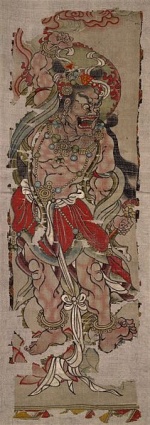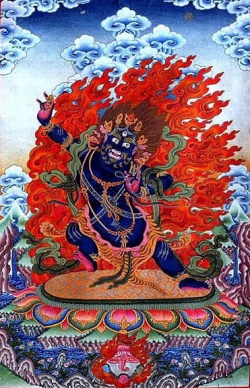Vajrapani

Vajrapāṇi (from Sanskrit vajra, "thunderbolt" or "diamond" and pāṇi, lit. "in the hand") is one of the earliest bodhisattvas of Mahayana Buddhism. He is the protector and guide of the Buddha, and rose to symbolize the Buddha's power. Vajrapani was used extensively in Buddhist iconography as one of the three protective deities surrounding the Buddha. Each of them symbolizes one of the Buddha's virtues: Manjusri (the manifestation of all the Buddhas' wisdom), Avalokitesvara (the manifestation of all the Buddhas' compassion) and Vajrapani (the manifestation of all the Buddhas' power as well as the power of all 5 Tathagathas). Furthermore, Vajrapani is one of the earliest Dharmapalas and the only Buddhist deity to be mentioned in the Pali Canon as well as be worshiped in the Shaolin Temple, Tibetan Buddhism, and even Pure Land Buddhism (where he is known as Mahasthamaprapta and is one of a Triad comprising Amitabha and Avalokiteshwara). Manifestations of Vajrapani can also be found in many Buddhist temples in Japan as Dharma protectors called Nio. Vajrapani is also associated with Acala who is venerated as Fudo-Myo in Japan where he is serenaded as the holder of the Vajra. Vajrapani here is different from that mentioned in the Vedas as Indra, the king of the Gods and the most widely mentioned deity in all of the Indian scriptures.
Names
In Sanskrit, Vajrapani is also known as vajra-sattva. The Sutra of Golden Light entitles him "great general of the yakshas". Other name-forms are as follows.
- Bengali: Bojropani (বজ্রপাণি)
- Tibetan: Channa Dorje
- Mandarin: Jīngāng shǒu púsà (金剛手菩薩), Héyíluóhuányuèchā (和夷羅洹閱叉) or Báshéluóbōnì (跋闍羅波膩)
- Vietnamese: Kim cương thủ bồ tát, Hoà di la hoàn duyệt xoa or Bạt xà la ba nị
- Malay and Indonesian: Wajrapani
- Mongolian: Ochirvaani (Очирваань) or Bazarvaani (Базарваань)
- Korean: Geumgang su bosal (금강수보살) or Balsarapani (발사라파니)
- Japanese: Kongō shu bosatsu (金剛手菩薩), Wairaoneisa (和夷羅洹閱叉) or Bajarahaji (跋闍羅波膩)
Doctrine
On the popular level, Vajrapani, Holder of the Thunderbolt Scepter (symbolizing the power of compassion), is the Bodhisattva who represents the power of all the Buddhas, just as Avalokitesvara represents their great compassion, Manjushri their wisdom, and Tara their miraculous deeds. For the yogi, Vajrapani is a means of accomplishing fierce determination and symbolizes unrelenting effectiveness in the conquest of negativity. His taut posture is the active warrior pose (pratayalidha), based on an archer's stance but resembling the en garde position in Western fencing. His outstretched right hand brandishes a vajra and his left hand deftly holds a lasso - with which he binds demons. Although he wears a skull crown in a few depictions, in most depictions he wears a 5 pointed Bodhisattva crown to depict the power of the 5 Tathagathas. (The skull crown is an iconographic symbol of another similar Dharmapala called Mahakala). Vajrapani's expression is wrathful and he has a third eye. Around his neck is a serpent necklace and his loin cloth is made up of the skin of a tiger, whose head can be seen on his left knee.
The Pali Canon's Ambattha Suttanta, which challenges the caste system, tells of one instance of him appearing as a sign of the Buddha's power. At the behest of his teacher, a young Brahmin named Ambatha visited the Buddha. Knowing the Buddha's family to be the Shakya clan who are Kshatriya caste, Ambatha failed to show him the respect he would a fellow Brahmin. When the Buddha questioned his lack of respect, Ambatha replied it was because the Buddha belongs to a "menial" caste. The Buddha then asked the Brahmin if his family was descended from a “Shakya slave girl”. Knowing this to be true, Ambatha refused to answer the question. Upon refusing to answer the question for a second time, the Buddha warned him that his head would be smashed to bits if he failed to do so a third time. Ambatha was frightened when he saw Vajrapani manifest above the Buddha's head ready to strike the Brahmin down with his thunderbolt. He quickly confirmed the truth and a lesson on caste ensues.
According to the Pancavimsatisahasrika and Astasahasrika Prajnaparamita any Bodhisattva on the path to Buddhahood is eligible for Vajrapani's protection, making them invincible to any attacks "by either men or ghosts".
Mantras
The Mantra oṃ vajrapāṇi hūṃ phaṭ is associated with Vajrapani. His Seed Syllable is hūṃ.
Patron saint of Shaolin monastery

In his book The Shaolin Monastery (2008), Prof. Meir Shahar notes Vajrapani is the patron saint of the Shaolin Monastery. A short story appearing in Zhang Zhuo's (660-741) Tang anthology shows how the deity had been venerated in the Monastery from at least the eighth century. It is an anecdotal story of how the Shaolin monk Sengchou (480-560) gained supernatural strength and fighting ability by praying to the Vajrapani and being force-fed raw meat. Shaolin abbot Zuduan (1115–1167) erected a stele in his honor during the Song Dynasty. It reads:
- According to the scripture [Lotus Sutra], this deity (Narayana) is a manifestation of Avalokitesvara (Guanyin). If a person who compassionately nourishes all living beings employs this [deity's] charm, it will increase his body's strength (zengzhang shen li). It fulfills all vows, being most efficacious. ... Therefore those who study Narayana's hand-symbolism (mudra), those who seek his spell (mantra), and those who search for his image are numerous. Thus we have erected this stele to spread this transmission.
- — Stele re-erected (chong shang) by Shaolin's abbot Zuduan
Instead of being considered a stand alone deity, Shaolin believes Vajrapani to be an emanation of the Bodhisattva Guanyin. The Chinese scholar A'De noted this was because the Lotus Sutra says Guanyin takes on the visage of whatever being that would best help pervade the dharma. The exact Lotus Sutra passage reads: “To those who can be conveyed to deliverance by the body of the spirit who grasps the vajra (Vajrapani) he preaches Dharma by displaying the body of the spirit who grasps the vajra.” He was historically worshiped as the progenitor of their famous staff method by the monks themselves. A stele erected by Shaolin abbot Wenzai in 1517 shows the deity's vajra-club had by then been changed to a Chinese staff, which originally "served as the emblem of the monk". Vajrapani's Yaksha-like Narayana form was eventually equated with one of the four staff-wielding "Kimnara Kings" from the Lotus Sutra in 1575. His name was thus changed from Narayana to "Kimnara King". One of the many versions of a certain tale regarding his creation of the staff method takes place during the Yuan Dynasty's Red Turban Rebellion. Bandits lay siege to the monastery, but it is saved by a lowly kitchen worker wielding a long fire poker as a makeshift staff. He leaps into the oven and emerges as a monstrous giant big enough to stand astride both Mount Song and the imperial fort atop Mount Shaoshi (which are five miles apart). The bandits flee when they behold this staff-wielding titan. The Shaolin monks later realize that the kitchen worker was none other than the Kimnara King in disguise. Shahar notes the part of the kitchen worker might have been based on the actual life of the monk Huineng (638-713). In addition, he suggests the mythical elements of the tale were based on the fictional adventures of Sun Wukong from the Chinese epic Journey to the West. He compares the worker's transformation in the stove with Sun's time in Laozi's crucible, their use of the staff, and the fact that Sun and his weapon can both grow to gigantic proportions.
Statues and paintings of Kimnara were commissioned in various halls throughout Shaolin in honor of his defeat of the Red Turban army. A wicker statue woven by the monks and featured in the center of the "Kimnara Hall" was mentioned in Cheng Zongyou's seventeenth century training manual Shaolin Staff Method. However, a century later, it was claimed that Kimnara had himself woven the statue. It was destroyed when the monastery was set aflame by the KMT General Shi Yousan in 1928. A "rejuvenated religious cult" arose around Kimnara in the late twentieth century. Shaolin re-erected the shrine to him in 1984 and improved it in 2004.
The Buddhist monk Bodhidharma erroneously came to be known as the creator of the monastery's arts. This occurred when a Taoist with the pen name "Purple Coagulation Man of the Way" wrote the Sinews Changing Classic in 1624, but claimed to have discovered it. The first of two prefaces of the manual traces this qigong style's succession from Bodhidharma to the Chinese general Li Jing via "a chain of Buddhist saints and martial heroes." Scholars damn the work as a forgery because of its numerous anachronistic mistakes and the fact that popular fictional characters from Chinese literature, including the "Bushy Bearded Hero" (虬髯客), are listed as lineage masters. In fact, the Qing scholar Ling Tingkan (1757–1809) "dismissed the manual's author as an 'ignorant village master'."
Iconography
Just as Buddhaghosa associated Vajrapani with the Hindu god Indra, his first representations in India were identified with the thunder deity. As Buddhism expanded in Central Asia, and fused with Hellenistic influences into Greco-Buddhism, the Greek hero Hercules was adopted to represent Vajrapani. He was then typically depicted as a hairy, muscular athlete, wielding a short "diamond" club.
In Japan, Vajrapani is known as Shukongōshin (執金剛神, "Diamond rod-wielding God"), and has been the inspiration for the Niō (仁王, lit. Benevolent kings), the wrath-filled and muscular guardian god of the Buddha, standing today at the entrance of many Buddhist temples under the appearance of frightening wrestler-like statues. He is also associated with Fudo-Myo, an incarnation of Acala and the prayer mantra for Fudo Myo references him as the powerful wielder of the Vajra.
Some suggest that the war deity Kartikeya, who bears the title Skanda is also a manifestation of Vajrapani, who bears some resemblance to Skanda because they both wield vajras as weapons and are portrayed with flaming halos. He is also connected through Vajrapani through a theory to his connection to Greco-Buddhism, as Wei Tuo's image is reminiscent of the Heracles depiction of Vajrapani.

